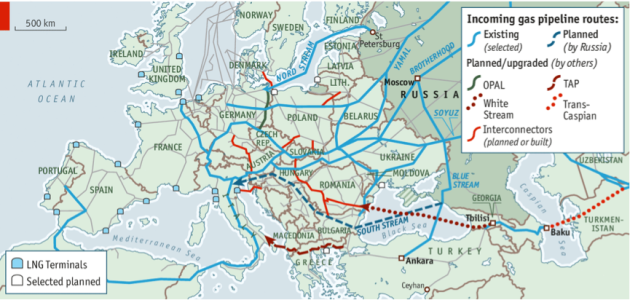With recent events in Ukraine strongly affecting security relations between the West and Russia, both Brussels and Moscow are increasing efforts to reduce their mutual energy-financial dependency.
European energy dependency is not a new thing. Despite aims to cut its energy imports, since 2000 the EU actually increased them by 10% (mainly by reducing domestic production of oil and coal), without providing an appropriate renewable energy substitute.
In 2012 alone, the EU spent more than $500 billion on imported oil and gas. In addition, with the shale revolution causing the costs of energy to tumble in the US in the past four years, there are growing concerns that high energy prices of energy will affect Europe’s global competitiveness.
The EU is determined to increase energy independence primarily by boosting renewable energy capacities in its energy mix. However, this comes at a price.
EU’s policy of cutting the levels of GHG emissions by 40% and producing 27% of its energy by 2030 is a demanding and expensive task that inevitably adds to the overall cost of energy. However, a recent report published by the European Commission estimates that renewable energy will be saving the EU some €50 billion annually by 2020 if the prices of fuel remain at today’s levels, and significantly more if the prices go up, as predicted by IEA, EIA and the European Commission.
Additionally, in 2010 renewable energy sources reduced imported fuel costs by €30 billion, which is roughly comparable to the amount of subsidies received by the renewable sector in the same year. Europe should therefore benefit from its aggressive pursuit of renewable energy in the long-term. That being said, this benefit gives little comfort to the European industry and consumers, who have to bear high energy costs in today’s harsh economic environment.
Renewable energy is only one part of the solution, however. Another important step is diversification of import sources, and since the Crimean crisis began, this is chiefly related to reducing overexposure to natural gas supplies from Russia. The Russian Federation is by far Europe’s largest provider of energy, with 32% of gas, 35% of oil and 27% of coal imports. Moreover, energy imports from Russia have increased by 10% since 2000.
Taking this into consideration, as well as the potential for a long-term security shift in relations with Russia, simply redirecting pipelines away from the vulnerable Ukrainian route and supporting projects such as the Nord Stream and the South Stream may no longer be enough.
In the short-term, Europe can rely on imports from the MENA region and Norway, but this alone cannot replenish imports from Russia. Europe has a well-developed network of LNG terminals, yet global LNG suppliers are already under intense strain to facilitate increasing demand, primarily from Asian markets. A potential gas crisis in Europe would inevitably cause LNG prices to go up and come close to the Asian levels of around $18 per million British thermal units (mmBtu), compared to the current European prices of around $10 mmBtu.
High hopes for US natural gas to be shipped to Europe, saving the continent with cheap energy supplies in the form of some sort of energy Marshall plan are fast receding, as the US first needs to develop its LNG export facilities. Even if the infrastructure were fully in place and politics were favourable, Europe would potentially benefit from having an additional reliable source of supply, but certainly not from subsidized American gas.
In addition, plans to expand its own shale gas resources have just begun to take shape, and even if it manages to overcome strong political and environmental resistance, it will take years before Europe even starts to feel benefits from the potential shale revolution.
The most reliable way to secure more energy for Europe is still a network of planned pipelines that would circumvent Russia and bring natural gas from Central Asia and the Caucasus. In 2018, the new Trans-Adriatic pipeline will come into operation with an additional 10 billion cubic meters (bcm) of natural gas available to European markets.
With all of this in mind, Europe will remain highly dependent on Russian gas as the cheapest and most accessible energy option. This is particularly important for EU countries that are almost entirely reliant on Russian gas, such as the Baltic countries, Bulgaria and Greece. Their energy options are further narrowed by their lack of interconnections with other European countries.
On the other hand, Moscow should be careful before using energy as a political tool. Russia’s oil and gas revenues make up around half of the federal budget and 70% of the country’s total exports. Furthermore, around 80% of its natural gas is exported to EU countries.
With the swelling deficit and a troubled economy, Russia cannot afford to lose its most lucrative client. However, the recent intervention in Ukraine has shown that the Kremlin is determined to preserve Russia’s security dominance in the region, with little regard for potential damage that this might inflict on the country’s economy and long-term relations with the West.
The most obvious way for Moscow to reduce its financial dependence on Europe is to establish stronger energy links with the Asian markets. If Russia and China manage to strike the long-negotiated deal on natural gas exports during President Putin’s visit to Beijing in May, Russia’s energy giant Gazprom will start to export 35 bcm of gas to China in 2018.
China is set to become Russia’s largest importer of gas, surpassing Germany, which imported 34 bcm of gas in 2012. If successful, the deal will give Russia greater maneuvering space in Europe, which in turn may toughen Moscow’s attitudes towards the West.














